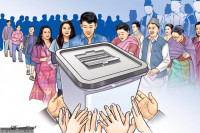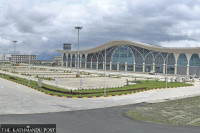National
Parties’ pledges weighing down national economy
They keep offering all kinds of freebies without taking into account country’s paltry resources and mounting debt.
Prithvi Man Shrestha
The government spent more than Rs120 billion paying off public debt in the past fiscal year. As things stand, the repayment amount of public debt continues to rise.
According to the Public Debt Management Office (PDMO), the government spent as much as Rs121.99 billion in 2021-2022 paying off domestic and foreign loans. The expenditure accounted for almost 11 percent of the total revenue the government collected in the fiscal year.
A total of Rs1.11 trillion in revenues had been collected in the year, according to an internal audit report on the government finances released by the Financial Comptroller General Office.
Resources spent on repaying public debt, paying salaries and allowances to government staff, and doling out pensions and social security benefits are among the committed government liabilities which burden the state coffers in the long run. Though certain domestic public debts can be rolled over, external debt has to be paid on the given date.
These liabilities have been continuously increasing given the political parties’ tendency to woo voters with freebies. With the government struggling to meet the revenue target in recent years, it has been relying on increasing debt.
According to the PDMO, the country’s total public debt stands at Rs2.01 trillion as of the last fiscal year with a rise of Rs1.73 trillion in the previous fiscal year. The total debt stood at 41.5 percent of the Gross Domestic Product (GDP) in the fiscal year 2021-22, up from 30.3 percent in 2017-18.
According to the Annual Report 2021-22 of the PDMO, the debts surged as the country began to take more loans for post-earthquake reconstruction and following the Covid crisis.
Along with the rise in public debt, the annual debt repayment has also been increasing over the past few years.
For example, the government had spent Rs71.92 billion in debt servicing in 2017-18, which climbed to more than Rs120 billion in the past fiscal 2021-22, according to the PDMO.
“I don’t consider debt instalment of more than 10 percent of the national revenue a small payment,” said former finance secretary Sishir Dhungana. “It is obviously a significant amount, but it’s not alarming as well.”
According to Dhungana, the more important thing to be considered while discussing the size of public debt is whether it has been properly used in productive sectors.
Along with repayment of public debt, a huge amount is also spent on salaries, pension and social security, adding to the government’s long-term liability.
For example, through the budget for the current fiscal year, the government hiked the salary of the government staff by 15 percent, reduced the eligibility age for elderly allowance to 68 years from the previous 70 years, and announced a “pension programme” for farmers, under which the government would contribute 10 percent of farmers’ total deposits to the programme.
The increase in salaries and reduction in the eligibility age for the elderly allowance will create an additional liability of around Rs76 billion in the current fiscal year alone, according to the Finance Ministry.
The government has allocated Rs440.43 billion for salaries, pension and social security for the current fiscal year, up from Rs364.44 billion in the last fiscal year. The cost of salaries and allowances for government employees and office bearers this year would rise by more than Rs44 billion, according to the budget document.
In fact, the lowering of the eligibility age for elderly allowance has already created a financial burden of Rs5.46 billion in the first quarter of the current fiscal year as 113,911 new beneficiaries were added.
The number of beneficiaries is expected to rise to more than 200,000 by the end of the current fiscal year, increasing the cost by over Rs7 billion, according to officials at the Department of National ID and Civil Registration, which deals with the social security allowance.
Furthermore, the political parties in their election manifestos have promised many freebies including further lowering the eligibility age for elderly allowance, increase in social security allowance, free electricity and free water. For example, the ruling Nepali Congress promised to lower the eligibility age for elderly allowance from 68 years to 65 years at a time when the life expectancy of Nepali people has been increasing.
The CPN-UML has promised to increase the social security allowance for all types of beneficiaries, while also promising to provide free electricity of up to 50 units a month.
The UML and the CPN (Unified Socialist) have also promised free drinking water up to 10,000 litres a month, for each household.
“If we look at the manifestos of the political parties, they are full of promises of freebies,” said former Nepal Rastra Bank Governor Chiranjeevi Nepal. “They are, however, silent on how they would generate the resources to fund those free schemes.”
These promises were made at a time when the government failed to meet the revenue targets in the fiscal years 2020-21 and 2021-22. It has fallen short of its revenue collection target during the first quarter of the current fiscal year too, according to the finance ministry.
“The revenue being collected is barely enough to sustain recurrent expenditures,” said Nepal. “A poor country like Nepal cannot provide social security to its citizens on par with developed countries like Denmark and Norway.”
In the fiscal year 2020-21, Rs68.61 billion were spent on social security allowances, according to the Department of National ID and Civil Registration.
The government expected it to rise to Rs88.68 billion in the last fiscal year 2021-22. As per the budgetary provision, Rs105.70 billion have been allocated for the current fiscal year.
Experts say that the government's increased committed liability means it will have less resources to invest in other vital sectors such as infrastructure, health and education.
“Nepal has a lot of underinvestment in education and health. You cannot increase investment in such vital sectors if you spend a lot on freebies that also create long-term liabilities,” said the former Auditor General Bhanu Acharya.
According to experts, more revenues will have to be raised to finance both development needs and growing administrative expenditures. For this, the government needs to promote imports and take out more loans to finance the resources gap, they said.
Nepal has already experienced the effect of unbridled imports as the balance of payment deficit widened and foreign exchange reserves slumped, creating fears that the country is heading towards a Sri Lanka-like crisis.
The government was forced to ban the import of certain goods, including vehicles and liquors. As a result, revenue collection has suffered. On the other hand, the government has also been increasing public debt to close the resource gap.
“The country is facing economic challenges due to its declining foreign exchange reserves as a result of high imports,” said Pushpa Lal Shakya, an economic expert. “Nepal has also been forced to make large payments due to its increasing debt, and the strengthening of the US dollar against the Nepali currency is making things worse.” Likewise, increasing interest rate on domestic debt amid a liquidity crunch has also increased the government’s debt liabilities.
Increased reliance on debt financing to meet the country's development needs could be risky, according to experts. “Nepal has many projects, including the Melamchi Drinking Water Project, which have missed their completion dates by several years. So, there is no guarantee of timely returns on investment, made by taking out loans. So there is a risk of an increased debt liability,” said Acharya, the former finance secretary.




 8.12°C Kathmandu
8.12°C Kathmandu















